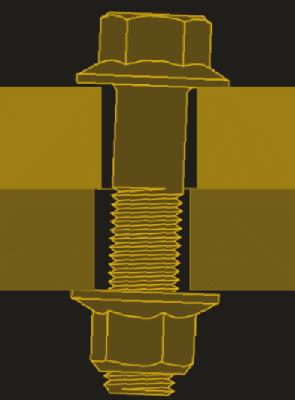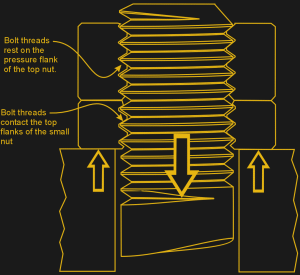How To Keep A Nut From Loosening
Information technology's not much of a stretch to say that without nuts and bolts, the globe would fall apart. Bolted connections are everywhere, from the frame of your DIY 3D printer to the lug nuts belongings the wheels on your auto. Though the penalty for failure is certainly higher in the latter than in the old, self-loosening of nuts and bolts is rarely a good thing. Engineers have come up with dozens of ways to make sure the world doesn't autumn autonomously, and some work better than others. Let's explore a few of these methods and notice out what works, what doesn't work, and in the process maybe we'll learn a little well-nigh how these fascinating fasteners piece of work.
What Doesn't Work

In that location are enough of ways for a bolted articulation to fail, simply vibration-induced self-loosening is perchance the about insidious. Anyone who has always pounded on a stuck bolt or used an impact wrench to remove a rusty nut knows that vibration really helps. Put that same joint into service and subject information technology to the right kind of vibration, and there's a good take a chance the connectedness volition self-loosen and cause the articulation to fail.
In the 1960s, German language engineer Gerhard Junker studied self-loosening and came to the conclusion that transverse vibrations were responsible for the failure of bolted connections. He devised a unproblematic examination apparatus that provided rapid transverse vibrations while monitoring fastener preload tension with a load jail cell. Graphing preload as a function the number of vibratory cycles yielded clues equally to the effectiveness of various locking methods. The examination became known every bit the Junker examination and every bit standard DIN 65151, it remains the gold standard for testing self-loosening.
In that location are some fascinating videos out at that place showing Junker tests in action, and some are downright scary. Typically, we'll throw a simple helical spring lock washer on a stud or bolt, torque down the nut overnice and snug, and call it a mean solar day, feeling similar we've made a secure joint. But aught could be further from the truth. In fact, the video beneath shows that not only do lock washers add together very fiddling security to bolted connections, none of the other common methods — plain washers, nylon insert nuts, and stacked basics — provide much help either.
What Does Work

Obviously, the video above is aimed at marketing the visitor's fancy wedge-locking washers, and it's pretty clear that they work well. But why do they piece of work when a simple lock washer fails? To answer that, it pays to look at what else works, something that wasn't tested in the video — a properly installed jam nut.
A jam nut is a low-profile nut, typically about half the height of a standard nut, that's installed below the larger nut. When the jam nut is installed, it's tightened but to about a quarter to a half of the full final torque. The thick nut is installed adjacent and torqued to the terminal value while the jam nut is held in place with a wrench. This effectively pulls the commodities up through the jam nut. The threads of the bolt are then in contact with the superlative flanks of the threads within the jam nut, while simultaneously contacting the upper or force per unit area flanks of the tiptop nut. With the tiptop and bottom basics providing opposing forces on the bolt, the nuts are far less likely to cocky-loosen.
A similar mechanism is at piece of work in the wedge-locking washers. The two halves of the washer accept interlocking wedges, the angle of which exceeds the pitch of the bolt threads. Every bit the bolt is tightened, the higher pitch of the washers pulls the bolt dorsum upwards, providing an opposing forcefulness to jam the threads and prevent the fastener from self-loosening.
If nosotros await at all the locking methods that fail, they all have something in mutual: they all rely on friction. Jam nuts and wedge-lock washers piece of work by providing tension to oppose the transverse vibrations that lead to self-loosening and are therefore much more effective.
Of course, there are other methods of locking threaded fasteners. Adhesive thread lockers come to mind, as practice more complicated methods like wired nuts and tabbed washers, and they can be very effective methods. But for low toll and ease of installation, it'southward difficult to beat a unproblematic jam nut to keep the world from falling apart.
Featured paradigm source: Nord-LockGroup
Source: https://hackaday.com/2017/06/08/nuts-and-bolts-keeping-it-tight/

0 Response to "How To Keep A Nut From Loosening"
Post a Comment